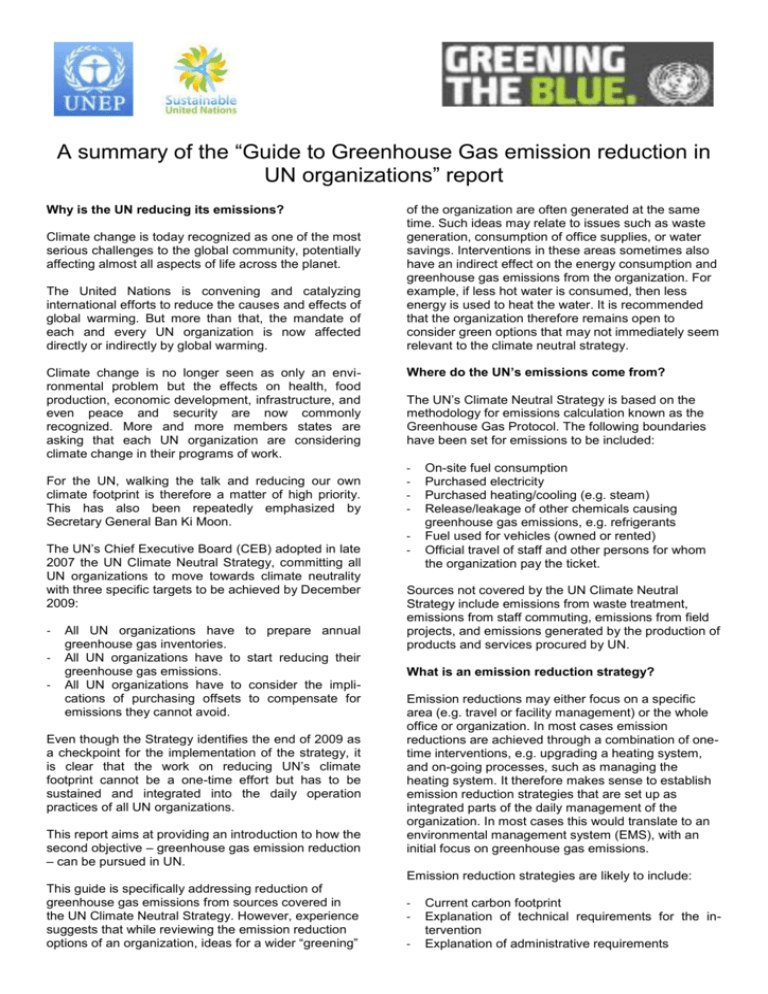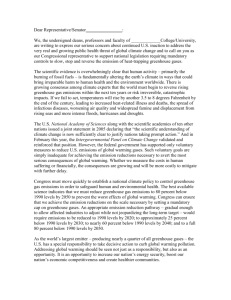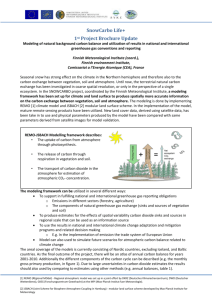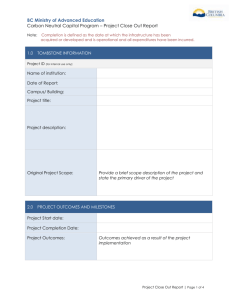Guide to Greenhouse Gas emission reduction in
advertisement

A summary of the “Guide to Greenhouse Gas emission reduction in UN organizations” report Why is the UN reducing its emissions? Climate change is today recognized as one of the most serious challenges to the global community, potentially affecting almost all aspects of life across the planet. The United Nations is convening and catalyzing international efforts to reduce the causes and effects of global warming. But more than that, the mandate of each and every UN organization is now affected directly or indirectly by global warming. Climate change is no longer seen as only an environmental problem but the effects on health, food production, economic development, infrastructure, and even peace and security are now commonly recognized. More and more members states are asking that each UN organization are considering climate change in their programs of work. For the UN, walking the talk and reducing our own climate footprint is therefore a matter of high priority. This has also been repeatedly emphasized by Secretary General Ban Ki Moon. The UN‟s Chief Executive Board (CEB) adopted in late 2007 the UN Climate Neutral Strategy, committing all UN organizations to move towards climate neutrality with three specific targets to be achieved by December 2009: - All UN organizations have to prepare annual greenhouse gas inventories. All UN organizations have to start reducing their greenhouse gas emissions. All UN organizations have to consider the implications of purchasing offsets to compensate for emissions they cannot avoid. Even though the Strategy identifies the end of 2009 as a checkpoint for the implementation of the strategy, it is clear that the work on reducing UN‟s climate footprint cannot be a one-time effort but has to be sustained and integrated into the daily operation practices of all UN organizations. This report aims at providing an introduction to how the second objective – greenhouse gas emission reduction – can be pursued in UN. of the organization are often generated at the same time. Such ideas may relate to issues such as waste generation, consumption of office supplies, or water savings. Interventions in these areas sometimes also have an indirect effect on the energy consumption and greenhouse gas emissions from the organization. For example, if less hot water is consumed, then less energy is used to heat the water. It is recommended that the organization therefore remains open to consider green options that may not immediately seem relevant to the climate neutral strategy. Where do the UN’s emissions come from? The UN‟s Climate Neutral Strategy is based on the methodology for emissions calculation known as the Greenhouse Gas Protocol. The following boundaries have been set for emissions to be included: - On-site fuel consumption Purchased electricity Purchased heating/cooling (e.g. steam) Release/leakage of other chemicals causing greenhouse gas emissions, e.g. refrigerants Fuel used for vehicles (owned or rented) Official travel of staff and other persons for whom the organization pay the ticket. Sources not covered by the UN Climate Neutral Strategy include emissions from waste treatment, emissions from staff commuting, emissions from field projects, and emissions generated by the production of products and services procured by UN. What is an emission reduction strategy? Emission reductions may either focus on a specific area (e.g. travel or facility management) or the whole office or organization. In most cases emission reductions are achieved through a combination of onetime interventions, e.g. upgrading a heating system, and on-going processes, such as managing the heating system. It therefore makes sense to establish emission reduction strategies that are set up as integrated parts of the daily management of the organization. In most cases this would translate to an environmental management system (EMS), with an initial focus on greenhouse gas emissions. Emission reduction strategies are likely to include: This guide is specifically addressing reduction of greenhouse gas emissions from sources covered in the UN Climate Neutral Strategy. However, experience suggests that while reviewing the emission reduction options of an organization, ideas for a wider “greening” - Current carbon footprint Explanation of technical requirements for the intervention Explanation of administrative requirements - Estimated emission reduction through the proposed interventions. Estimated cost for the interventions Estimated savings from the intervention (e.g. through reduced energy use, reduced travel costs, and reduced offset costs). Responsibility for implementation Implementation schedule How can emissions from travel be reduced? Emission reductions from travel can be achieved in two ways: reduced travel and/or more efficient travel. Travel can be reduced through top-down targets,„bundling‟ of missions, using staff in local offices, reducing the number of participants to meetings and using alternative means of communication. More efficient travel can be achieved through opting for the train over the plane for short haul journeys, encouraging travel in economy instead of business class, a ban on business class travel and better selection of routes. Other travel-related issues to consider include the introduction of a sustainable travel policy, mechanisms for implementing new approaches to travel, monitoring of travel and use of frequent flyer miles. How can emissions from buildings be reduced? There are three ways of reducing emissions from buildings: 1) Passive measures - focused on reducing the need for energy consumption (e.g. reduce the need for artificial lighting). The main examples of this are: improving insulation, reducing heat transfer through windows, enhancing natural daylight and optimising natural ventilation. 2) Active measures - focused on improving the efficiency of systems consuming energy e.g. heating / lighting. Reducing greenhouse gas emissions in these areas typically includes three types of interventions: a) switch to more efficient systems, b) improve management and maintenance of the systems and c) optimize the configuration of the systems. 3) Building management measures – focused on commissioning new systems and upgrading equipment. Careful monitoring and reporting of the performance of equipment can ensure early awareness of problems and malfunctions. Effective staff training in how to operate equipment is also vital to ensure equipment is used efficiently. How can processes reduce emissions? There are four main ways in which processes can be adapted to reduce emissions: 1) Sustainable Procurement – Emission reduction plans of organizations should provide staff in procurement with adequate training and access to sustainable procurement tools. 2) Administration - which is essential for the work of UN, but which can be made more efficient to reduce energy consumption and use of resources. 3) Budgeting – potentially enabling funding for greenhouse gas emission reduction. 4) Meetings - The main contributor to the footprint of a meeting is typically travel of meeting participants, but also production of meeting documents, catering, accommodation, local transport, and waste generation contribute. For more information on how to make a meeting green please refer to the Green Meeting Guide 2009 (http://www.unep.fr/scp/sun/publications) What role does organizational culture play in reducing emissions? Improved buildings, reduced travel, and revised processes will all contribute to emission reductions, however in the end it‟s the attitudes and behaviour of people in the organization which decides to what extent the changes will have any lasting impact. An organisation‟s culture can the drives the reduction in emissions. This can be coordinated through the adoption of a policy, including specific, measureable, achievable, realistic, time constrained, (SMART) targets. The policy needs to be supported by an Environmental Management System (EMS) and it will need to be championed by a senior manager/ director. Staff should be encouraged and incentivised to support the policy to ensure its success. How can you get started in reducing emissions? Responsibility for implementing the UN Climate Neutral Strategy rests formally with the head of each UN organization. Each organization also has an assigned person (normally at headquarters) responsible for coordinating the activities related to the climate neutral strategy. This person is the “Climate Neutral Focal Point” and will be able to provide advice and guidance on the progress of the climate neutral strategy. If you are the designated focal point, then talk with focal points in other organizations to share ideas. A summary of the basic steps are: 1) Identify and activate interested colleagues 2) Make the message relevant to the audience. E.g you don‟t have to link your work to environmental issues, chances are there will also be impacts in other areas e.g. issues of economy, efficiency, staff health etc. 3) Find out what issues interest staff 4) Prepare a plan 5) Get senior level support 6) Monitor results and share success For further information please read the full report: A Guide to Greenhouse Gas Emission Reduction in UN Organizations. Action Checklists MAKING REDUCTIONS FROM TRAVEL: 1. Travel less a. Take a policy decision to reduce travel by XX% b. Bundle long-haul missions to increase the length of the missions but reduce the number of trips c. Use local staff to reduce the need for long-haul travel d. Reduce the number of participants or staff attending the same meeting. e. Use alternative means of communication such as virtual (Internet based) meetings 2 Travel in more efficient ways a. When available, go by train instead of air on short-haul sectors b. Encourage travel in economy class instead of business class c. Give preference to airlines with modern (low emission) aircrafts d. Require travel agents to provide information on low greenhouse gas emission travel alternatives to the “business as usual” option e. Require travel agents to highlight on tickets and quotations the associated carbon footprint and offset cost. f. Require travel agents to give preference to routings and airlines that minimize the number of landings/takeoffs and use more modern aircraft. 3 Adopt a sustainable travel policy a. Include time bound emission reduction targets and defined responsibilities for implementation. 4 Implement rigorous screening of travel need and travel modes a. Establish formal checkpoints in travel planning and approval systems. 5 Raise awareness on why and how to reduce the travel-related carbon footprint a. Conduct awareness raising and training sessions with concerned staff (travelers, approving managers, travel assistants) and travel agents. 6 Monitor and compare travel patterns a. Track relevant departments‟ travels to better manage and set targets for emission reduction. MAKING REDUCTIONS FROM BUILDINGS: Passive measures Improve insulation of the building envelope 1. Reduce heat transfer through windows a. Change from single glass windows to double or triple glass windows b. Change from clear glass to e-coated glass c. Remove “thermal bridges” between the outside and inside d. Improve the seals between the inner and outer window frames e. Install exterior shading devices outside the windows 2. Enhance natural daylight in the office a. Remove non-structural interior walls, replacing them with transparent walls if appropriate b. Remodel the office layout to ensure that the more frequently used spaces are adjacent to windows c. Install light shelves; horizontal light-reflecting overhangs that are placed above eye-level and have a high-reflectance upper surface d. Use bright/light colors for interior decoration (walls, roof, floor and furniture) e. Install skylights (roof windows) or light tubes transmitting daylight into the interior of the building f. Leave blinds and curtains open in the daytime if compatible with heating/cooling. 3. Optimize natural ventilation, cooling and heating a. Establish ventilation corridors inside the building b. Enhance natural ventilation with solar chimneys c. Use night time natural cooling in hot climates and day time natural heat accumulation in cold climates d. Use under-roof ventilation and green roofs to decrease heat accumulation in hot climates e. Benefit from adjacent vegetation to direct or shield the building from prevailing wind flows and direct sunlight f. Use heat generated by office equipment to reduce the heating needs in cold climates. Active measures a. Switch to energy supply from renewable energy sources or purchase Renewable Energy Certificates. b. Produce on-site energy from renewable energy sources. c. Support heating/cooling with earth-energy cooling/heating systems. d. Reduce heating/cooling needs through heat recovery from the ventilation air. 1. Improve the performance of the Heating, Ventilation and Air Conditioning (HVAC) system by conducting a limited assessment or full retro-commissioning of the system. This may result in one or several of the following recommendations: a. Complete replacement with a more efficient system. b. Upgrade or replace parts of the existing equipment. c. Improve control of the HVAC system (increase the monitoring points, fine tune control parameters, upgrade standard operating procedures etc). d. Seal leaks in ducts, clean fans and filters. e. Improve training of operators. f. Establish monitoring and feedback systems. 2. Optimize the efficiency of lighting. Measures include: a. Provide the right level of lighting for the activities carried out. b. Only use high efficiency lamps, such as fluorescent lamps. c. Change from magnetic to electronic ballast in lamps. d. Regularly clean lamps/bulbs. e. Ensure that lights can be turned on individually for each room or work place. f. Install movement sensors in less frequently used spaces. g. Install timed central switches. 3. Reduce energy use by office equipment: a. b. c. d. e. f. Purchase energy efficient equipment. Activate energy saving features on the equipment. Ensure that equipment is turned off when the work day is over. Completely unplug electric equipment when possible, e.g. at night and on weekends. Replace individual equipment with common high-efficiency equipment Move from individual printers to Local Area Network (LAN) connected high-efficiency common printers/copying machines/scanners g. Replace physical servers with virtual servers. Building management measures: 1. Commissioning all new systems and upgrades of existing systems. 2. Retro-commission existing systems. 3. Define, monitor and report on the key parameters of the energy systems (e.g. energy use, air speed, temperatures) 4. As part of the above, set the indoor temperature so that it meets comfort levels without wasting energy on over heating or over cooling. 5. Use automated building management systems. 6. Provide training for key staff on proper operation and management of the building energy systems. 7. Encourage energy saving behavior among the building users. MAKING REDUCTIONS THROUGH PROCESSES: 1. Provide training on sustainable procurement to enable procurement of climate friendly goods and services 2. Pursue increased use of on-line administrative tools and paperless administration 3. Consistently reflect cost savings associated with emission reduction measures, such as energy savings and avoided offset costs 4. Adopt and implement a policy to conduct all meetings as green meetings, e.g.: a. Reduce the overall number of international meetings and overall number of participants. Use means of e-communication instead of physical meetings when possible. b. Select venues to minimize the need for long-haul travel and local environmental impact. c. Provide catering services that meet criteria for safe production and fair trade. d. Avoid the use of disposable plates, cups and bottles. e. Favour hotels that meet environmental criteria. f. Organize local transportation using less polluting modes of transport. REDUCTIONS THROUGH ORGANISATIONAL CULTURE: 1. Adopt an overall policy guiding and supporting the effort of the organization to reduce greenhouse gas emissions. 2. Establish an Environmental Management System to support practical implementation of the policy. 3. Assign a senior manager/director as champion for the climate neutral effort 4. Institute formal check points in key planning and management processes, including: a. Compulsory training for all staff. b. Require that project documents, memoranda of understanding and other forms of formal agreements, describe how the greenhouse gas emissions from related activities will be minimized. c. Include goals to support greenhouse gas emission reduction in staff work plans, such as the Performance Appraisal System (PAS). 5. Encourage staff support for a green and climate friendly organization through innovative incentives, such as: a. Increase the awareness through information campaigns, matched by incentives for staff to turn the message of the campaign into practical action, e.g. on recycling, local transport, use of double sided printing, use of recyclable cups etc. b. Provide an office setup that encourages sustainable and carbon-lean office practices, e.g. i. Use common printers, scanners and copying machines ii. Provide highly visible recycling stations iii. Organize work spaces so that they benefit from natural lighting iv. Use plants in the office as a way of improving the indoor environmental quality, both physically and mentally c. Develop and share with all staff monthly or quarterly key performance indicators (travel, paper use, waste generation, etc) for each department/division within the organization. d. Highlight and recognize emission reduction initiatives by individual staff or departments e. Consider using the UN Flex policy to allow distance work, thereby reducing the need for commuting and improving work-life balance f. Invite colleagues to provide suggestions on how to further improve the organizational culture to support sustainable and climate friendly behaviour MAKING REDUCTIONS THROUGH ORGANIZATIONAL CULTURE: 1. Adopt an overall policy guiding and supporting the effort of the organization to reduce greenhouse gas emissions. 2. Establish an Environmental Management System to support practical implementation of the policy. 3. Assign a senior manager/director as champion for the climate neutral effort. Institute formal check points in key planning and management processes, including: a. Compulsory training for all staff. b. Require that project documents, memoranda of understanding and other forms of formal agreements, describe how the greenhouse gas emissions from related activities will be minimized. c. Include goals to support greenhouse gas emission reduction in staff work plans, such as the Performance Appraisal System (PAS). Encourage staff support for a green and climate friendly organization through innovative incentives, such as: a. Increase the awareness through information campaigns, matched by incentives for staff to turn the message of the campaign into practical action, e.g. on recycling, local transport, use of double sided printing, use of recyclable cups etc. Provide an office setup that encourages sustainable and carbon-lean office practices, e.g. i. Use common printers, scanners and copying machines. ii. Provide highly visible recycling stations. iii. Organize work spaces so that they benefit from natural lighting iv. Use plants in the office as a way of improving the indoor environmental quality, both physically and mentally. c. Develop and share with all staff monthly or quarterly key performance indicators (travel, paper use, waste generation, etc) for each department/division within the organization. d. Highlight and recognize emission reduction initiatives by individual staff or departments. e. Consider using the UN Flex policy to allow distance work, thereby reducing the need for commuting and improving work-life balance. f. Invite colleagues to provide suggestions on how to further improve the organizational culture to support sustainable and climate friendly behavior.








